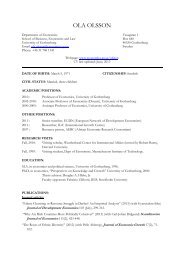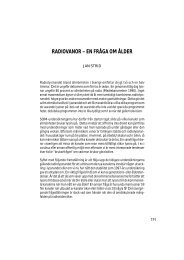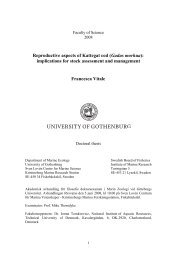Equal Opportunities Work - Theories about Practice
Equal Opportunities Work - Theories about Practice
Equal Opportunities Work - Theories about Practice
Create successful ePaper yourself
Turn your PDF publications into a flip-book with our unique Google optimized e-Paper software.
substantially different argument in terms of comprehensive schooling than in<br />
other areas of society.<br />
It should be clear from the above both that the Swedish authorities' view of<br />
equal opportunities in public education is based on the assumption that there<br />
are fundamental differences between the sexes, and also that this view is at<br />
least somewhat differently motivated than the general justification for an equal<br />
opportunities policy. In the general policy, the focus is more at the structural<br />
level. But when it comes to equal opportunities at school, the focus is<br />
completely individual.<br />
In the discussion pursued by the Swedish authorities of equal opportunities<br />
at universities and institutes of higher education, a third justification for an<br />
equal opportunities policy arises. There, it is seen not only as a democratic<br />
right, and thus a matter of justice, but also as a matter of quality. Briefly:<br />
having an equal opportunities policy is a means of improving quality.a<br />
What this means, concretely, in the sphere of higher education, is that<br />
working for equal opportunities is said to improve the quality of scientific,<br />
scholarly and educational performance.5 Efforts being made in terms of equal<br />
opportunities are also to be included when the Swedish National Agency for<br />
Higher Education makes quality assessments. This makes equal opportunities<br />
work justifiable not only from the point of view of justice, but also of costbenefit.6<br />
How, then, should equal opportunities work be justified within any<br />
organization? As we have seen, the two main arguments of the Swedish<br />
authorities are the justice argument and the quality argument. What differences<br />
result when each of these arguments is implemented? What do discussions<br />
<strong>about</strong> equal opportunities policies actually mean in relation to quality? Isn't the<br />
justice argument sufficient in itself?<br />
4 <strong>Equal</strong> opportunities work as a quality issue is one of the main themes of the final report from the<br />
"JAST"<br />
group (the <strong>Work</strong>ing Group on <strong>Equal</strong> <strong>Opportunities</strong> in Higher Education and Research. See Official<br />
communication from government ministries 1997:56 Jiimstiilldhet ft)r kunskap, insikt och kvalitet ("<strong>Equal</strong><br />
opportunities for knowledge, insights and quality". Further, see Official communication from government<br />
ministries 1994:l3O Kaftlciggning och utviirdering av jiimstiilldhetsprojekt inom universitet och hdgskolor<br />
("Surveying and Assessing the Quality of <strong>Equal</strong> <strong>Opportunities</strong> Projects at Universities and Other Institutes of<br />
Higher Education", pp. l -15).<br />
5 Offi.iul communication from government ministrie s 1997.56 Jrimsttiltdhet fbr kunskap, insikt och kvalitet,<br />
("<strong>Equal</strong> <strong>Opportunities</strong> for Knowledge, Insights and Quality". p.100).<br />
6 One additional way ofjustifying work for equal opportunities from a cost-benefit point of view is to clarify<br />
that equal opportunities work is profitbearing. See report from Nutek (the Swedish National Board for Industrial<br />
and Technical Development) 1999: 19 Jcimstrilldhet & linsamhet (<strong>Equal</strong> <strong>Opportunities</strong> and Profitability'). This<br />
particular argument for equal opportunities work falls beyond the scope ofthis article.

















